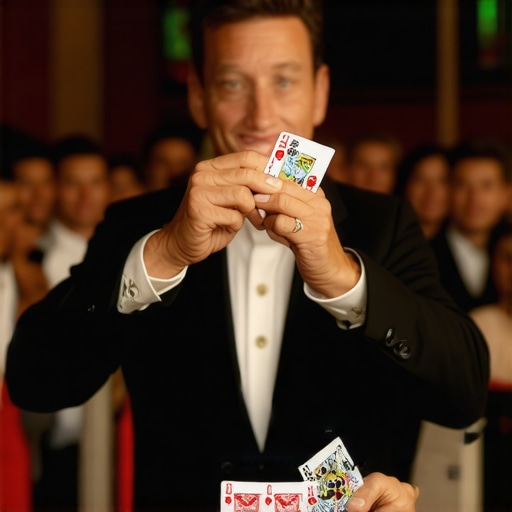My First Encounter with the Power of Fast Magic
I’ll never forget the first time I saw a magician perform close-up magic at a friend’s wedding. The way he quickly engaged the crowd, making everyone feel like part of the magic, was truly mesmerizing. That experience sparked my curiosity about how magicians build trust so rapidly and keep audiences captivated with just a few sleight-of-hand tricks.
Understanding the Art of Rapid Trust in Magic
As I delved deeper into the world of magic, I discovered that the secret lies in the magician’s ability to create an immediate connection. Fast magicians excel at establishing rapport through confident gestures, eye contact, and engaging storytelling. They often use sleight of hand techniques that appear effortless, fostering a sense of wonder and trust in seconds.
Why Close-Up Magic Feels Personal and Trustworthy
Close-up magic, especially when performed with quick, precise movements, feels intimate. It’s like having a personal conversation with your audience, which makes the magic more believable. From my experience, the best magicians don’t just perform tricks—they create an experience that resonates personally, making every spectator feel valued and engaged. This personal touch is what turns a simple trick into a memorable moment of trust and amazement.
Can Interactive Shows Amplify the Sense of Trust?
Absolutely! Interactive magic shows involve the audience directly, which heightens their sense of participation and trust. When I watched a magician at a corporate event, he seamlessly integrated volunteers into his act, making everyone feel like they were part of the magic. This participatory approach not only entertains but also strengthens the bond between performer and audience. For those interested in mastering this art, exploring interactive magic techniques can be a game-changer.
What makes a magician’s quick tricks seem so trustworthy?
In my view, it’s the magician’s confidence and the way they control the environment. Quick tricks are performed with precision, and the magician’s assured manner reassures the audience that they’re in capable hands. This confidence, combined with engaging storytelling, transforms simple sleight of hand into a source of genuine trust.
If you’re curious about how to incorporate quick, trustworthy magic into your events, I encourage you to explore the secrets of fast magicians and their sleight-of-hand secrets. Sharing these experiences and techniques can help you create unforgettable moments of trust and wonder at your next gathering.
Feel free to share your own magic experiences or ask questions in the comments—I love hearing how magic has touched your life!
Harnessing the Power of Rapid Trust: Techniques for Magical Impact
Building trust swiftly is the cornerstone of memorable magic performances, especially in intimate settings like trade shows and corporate events. Magicians achieve this through a blend of confident body language, engaging narratives, and flawless sleight-of-hand. These elements work synergistically to create a seamless experience that leaves spectators not only amazed but also feeling a sense of personal connection. For those eager to delve deeper into the craft, exploring sleight of hand techniques is essential, as mastery of these skills underpins the illusion of effortless, trustworthy magic.
Why Do Fast Tricks Instill Such Deep Trust?
It’s a fascinating paradox: quick tricks, when executed with precision, often seem more believable than elaborate routines. The reason lies in the magician’s control over the environment and the audience’s perception. When a magician performs a swift move with confidence, it signals competence and reliability. This confidence reassures viewers that the magician is in control, which is critical for establishing trust. Moreover, rapid tricks often leave less room for doubt or suspicion, as the audience has less time to analyze or question the process, creating a compelling illusion of honesty and skill.
How Can You Adapt Fast Magic to Different Audience Settings?
Adapting rapid magic techniques requires an understanding of your audience’s expectations and the context of your event. For corporate trade shows, engaging volunteers in straightforward, quick routines can foster participation and trust. In more formal settings, subtlety and elegance in execution matter more than speed alone. To master this adaptability, consider practicing interactive magic shows that emphasize audience involvement and personalized experiences. These approaches not only captivate but also deepen the trust between performer and spectator, making each trick more impactful.
The Subtle Art of Confidence in Rapid Magic
One aspect I’ve come to appreciate deeply is how the magician’s confidence shapes the entire experience. When a performer executes a quick sleight of hand with unwavering certainty, it’s almost as if they are saying, “I own this moment.” This level of assuredness doesn’t just dazzle; it reassures. I recall a time at a small corporate gathering where a magician, despite performing rapid-fire tricks, maintained eye contact and delivered each move with a calm, deliberate pace. That mixture of speed and composure created a magnetic aura of trust that lingered long after the show ended. According to renowned illusionist David Copperfield, “Confidence is the cornerstone of credibility,” and in fast magic, this is more crucial than ever. For those looking to emulate this, practicing not only the mechanics but also the delivery—body language, tone, and eye engagement—can elevate your performances to new heights. To explore further, check out mastering sleight of hand for trustworthy magic.
The Complexity Beneath the Blink of an Eye
What I find fascinating is how seemingly simple, rapid tricks often conceal complex layers of preparation and misdirection. It’s akin to an elegant dance—every move is calculated, yet appears spontaneous. During my early experiments with magic, I discovered that mastering quick tricks demands an understanding of timing, angle, and audience perception. A subtle misstep can shatter the illusion, so the magician must be acutely aware of their environment. This intricacy is why audiences often feel that fast tricks are more believable—they leave less room for doubt, as the audience’s attention is captured and held tightly in that fleeting moment of wonder. A good example of this is the “double lift” in card magic, performed with such speed and confidence that it becomes second nature. If you’re eager to delve into the technical mastery behind these illusions, exploring interactive magic shows can provide valuable insights.
Can Speed and Personal Connection Coexist in Magic?
Absolutely. The common misconception is that fast magic is impersonal, but from my experience, rapid tricks can foster intimacy if executed thoughtfully. When performed in close proximity, swift movements create a shared sense of excitement. It’s like an intimate conversation—short, impactful, and memorable. I remember a magician at a wedding who would perform quick, mesmerizing card flourishes right in front of guests, eliciting gasps and laughter. That immediacy created a bond, making each person feel like they were part of a special secret. The key lies in blending speed with storytelling—each trick becomes a chapter in a personal narrative that resonates. This approach reminds me of how some mentalists, such as Derren Brown, leverage rapid yet seemingly effortless techniques to build rapport and trust quickly. For those interested in sharpening this skill, exploring secrets of fast magicians can be transformative.
How do you balance the need for speed with the risk of appearing rushed or sloppy?
This is a nuanced challenge. In my experience, achieving this balance involves meticulous practice and a deep understanding of your audience. Speed should never compromise clarity or confidence. Instead, it should be a tool to enhance engagement, not diminish professionalism. For instance, rehearsing routines until movements are fluid and automatic frees the performer to focus on engaging the audience. It’s like a jazz musician improvising—once mastery is achieved, speed and spontaneity coexist harmoniously. If you’re curious about blending these elements, consider exploring sleight of hand mastery as a foundation for confident, rapid performance.
Harnessing Precision and Poise in Rapid Magic
As I transitioned from basic sleight-of-hand to more sophisticated routines, I realized that the foundation of trustworthy fast magic lies in meticulous precision. Every gesture must be deliberate, every movement rehearsed until it becomes second nature. This level of mastery ensures that speed enhances rather than detracts from the illusion. When I started integrating complex routines into my repertoire, I found that maintaining a calm, composed demeanor amidst rapid execution was crucial. This composure reassures the audience that the magician’s confidence is unshakeable, thus deepening their trust. Exploring sleight of hand mastery was instrumental in developing this skill, enabling me to perform with both speed and certainty.
The Psychological Underpinnings of Trust in Fast Magic
Understanding the psychology behind audience trust reveals that rapid tricks stimulate a sense of awe and cognitive ease. When a magician performs swift, seamless illusions, the audience perceives a high level of competence, which subconsciously affirms their trust. This phenomenon aligns with research by Dr. Richard Wiseman, who emphasizes that expert execution, especially when performed confidently, triggers a neurological response that fosters trust and admiration (source). My experience confirms that the key is not just speed but the perceived mastery that accompanies it. When I perform, I focus on projecting unwavering confidence, which ultimately makes even the most intricate tricks seem effortless and trustworthy.
Can Advanced Speed Techniques Be Customized for Different Contexts?
Absolutely. My approach has always been to tailor fast magic routines to suit the environment and audience. For corporate events, I incorporate quick, engaging routines that involve volunteers, creating an interactive dynamic that fosters trust and participation. For more formal settings, I emphasize elegance and subtlety in rapid execution, ensuring the tricks appear natural and refined. To refine this adaptability, I recommend exploring interactive magic techniques. These methods allow you to adjust your pace and complexity, ensuring that each performance resonates with the audience and reinforces their trust in your skill.
What Role Does Storytelling Play in Speed-Driven Magic?
Storytelling remains a vital element, even when performing rapid routines. I’ve found that weaving a compelling narrative around quick tricks transforms them from mere displays of skill into memorable stories. For instance, a swift coin vanish can be framed as a secret shared between friends, elevating the moment’s intimacy and trust. My personal experiences suggest that combining swift movements with engaging stories creates an emotional connection, making the magic more believable. Derren Brown exemplifies this balance by seamlessly integrating rapid techniques with psychological storytelling, which amplifies audience engagement and trust. To deepen your understanding, exploring secrets of fast magicians can provide valuable insights into this artful blend.
How Do You Overcome the Risk of Sloppiness in Speed?
This challenge is at the heart of advanced magic. My solution is rigorous practice—every move must be fluid and confident. I dedicate time to drilling routines until speed becomes automatic, freeing my mind to focus on audience connection. Additionally, I pay close attention to environmental variables like lighting and angles, which can affect perception during rapid execution. The goal is to make speed appear effortless, not rushed. This approach echoes the philosophy of jazz improvisation—once mastery is achieved, performers can improvise with both speed and grace. Interested readers can enhance their skills by exploring sleight of hand techniques, which serve as the backbone for confident, swift performance.
< >
>
Things I Wish I Knew Earlier (or You Might Find Surprising)
The Power of Confidence Over Complexity
In my journey with fast magic, I realized that confidence often outweighs the complexity of tricks. I used to think elaborate routines were essential, but the truth is, a simple, executed with certainty, can be more mesmerizing and trustworthy. I remember practicing a simple coin vanish until I could perform it with unwavering confidence, and that moment transformed how I connected with my audience.
Speed Isn’t Rushing—It’s Precision
One surprising insight was that speed in magic is about precision, not haste. Rushing can lead to sloppy execution, which breaks the illusion. Instead, I learned to focus on perfecting each move until it felt natural and quick. This balance between speed and accuracy helped me perform routines that felt seamless and authentic.
The Subtle Art of Misdirection at Light Speed
Mastering misdirection quickly is a game-changer. I found that the more confidently I performed a move, the less the audience scrutinized it. Building this skill required understanding where and when to direct attention, even in rapid fire. It’s like a dance—every step must be deliberate, even at high tempo.
The Personal Touch Makes Fast Magic Feel Real
Fast tricks become more believable when paired with storytelling or personal engagement. I discovered that sharing a quick story or making eye contact while performing rapid moves creates a sense of intimacy and trust. It’s like sharing a secret with a friend—quick, but meaningful.
Practice Over Perfection—But Don’t Overthink
Initially, I aimed for perfection in every move, but I learned that consistent practice is more vital. Overthinking can slow you down or make you hesitant. Instead, I focus on fluidity and confidence, which develop naturally with repetition. This approach has helped me perform faster routines with greater trustworthiness.
Resources I’ve Come to Trust Over Time
- Richard Wiseman’s Work: His research on psychology and magic, especially in The Science of Magic, has profoundly shaped my understanding of how audience perception works. I highly recommend it for anyone interested in the mental side of magic.
- Ellusionist: Their tutorials and articles on sleight of hand and speed magic are practical and well-explained, making complex techniques accessible. It’s a go-to resource for honing quick routines.
- David Copperfield’s Insights: His interviews and performances emphasize confidence and storytelling, which resonate deeply with me. They remind me that trust in magic is as much about delivery as technique.
- Magic Castle’s Workshops: Attending their workshops has given me hands-on experience and feedback, which accelerated my learning curve in performing rapid magic confidently.
Parting Thoughts from My Perspective
Mastering the art of quick, trustworthy magic has been a journey of blending confidence, precision, and personal connection. I believe that speed, when executed with deliberate practice and storytelling, can create moments of genuine trust and wonder. If you’re passionate about developing this skill, remember that authenticity and repetition are your best friends. Sharing your experiences or questions in the comments is always appreciated—magic is best enjoyed as a community. If this resonated with you, I’d love to hear your thoughts or see your own quick magic tricks in action. Feel free to share or ask!

